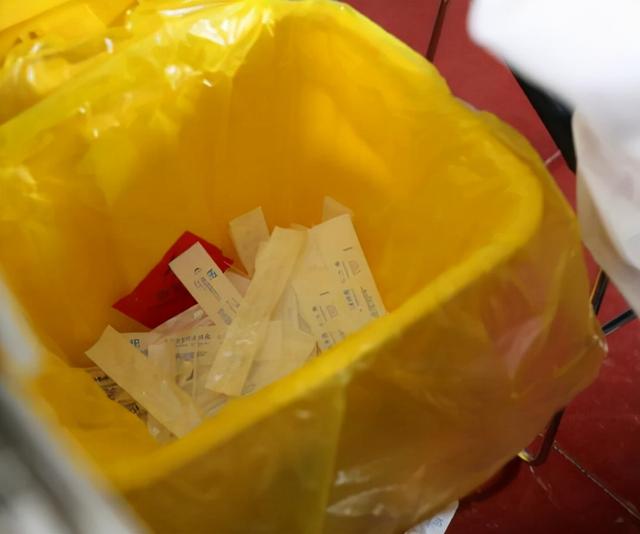病院は綿棒の廃棄物をどう扱うか
2024-11-06
病院内, 綿棒 標本収集のための重要なツールです, 感染症対策, および診断テスト. しかし, 綿棒廃棄物の管理は、環境の持続可能性と患者の安全の両方を確保するために医療施設が対処しなければならない複雑な問題です. 綿棒やその他の医療廃棄物の廃棄は、汚染を最小限に抑え、感染の拡大を防ぐために厳格なガイドラインによって規制されています。. 病院における綿棒廃棄物の管理方法の概要は次のとおりです。:
綿棒を適切に廃棄することの重要性
綿棒, 綿棒も含めて, 泡綿棒, そして植毛綿棒, 幅広い医療処置で使用されています. 使用後, 体液で汚染されていることが多い, 病原体, または化学物質. スワブ廃棄物の不適切な廃棄は相互汚染を引き起こす可能性があります, 感染症の蔓延, および環境上の危険性. 病院は安全な取り扱いを確保するために保健当局や環境保護機関が定めたガイドラインに従う必要があります。, 廃棄, これらの材料のリサイクルと.
ステップ 1: 医療廃棄物の分類
病院が綿棒廃棄物を管理する際に最初に行うステップの 1 つは、廃棄物を正しく分類することです. 綿棒の廃棄物は次のカテゴリに分類されます。 “規制された医療廃棄物” (RMW) 感染の可能性があるため. 医療廃棄物は通常、次のカテゴリに分類されます。:
- 感染性廃棄物: これには、検体の採取や傷のケアに使用され、体液や病原体で汚染された綿棒が含まれます。.
- 鋭利物廃棄物: 綿棒自体は鋭利ではありませんが、, 針やその他の鋭利な物体で汚染される可能性があるため、適切に処分してください。.
- 非感染性廃棄物: 一部の綿棒は非感染性物質で汚染されている可能性があり、非危険物として分類されています。.
廃棄物を正しく分別することで、, 病院は、それぞれの種類の廃棄物が適切な方法で確実に処理されるようにする.
ステップ 2: 安全な廃棄と分別
綿棒の廃棄物が収集されたら, 色分けされていて、, 医療廃棄物の現地規制要件に準拠した漏れ防止容器. ほとんどの病院では, 3層の廃棄物分別システムが使用されています:
- 赤いビン: 感染性廃棄物用, ウイルスや細菌感染の検査に使用される綿棒など.
- 黄色のビン: 感染性はないかもしれないが注意して取り扱う必要がある一般医療廃棄物用.
- シャープな容器: 使用済みの針や綿棒と接触した可能性のある鋭利な物体用.
各廃棄物容器は密閉されており、漏れを防ぎ、感染のリスクを最小限に抑えます。. 病院も専門医療機関を活用しています, 廃棄場所に輸送される前に、使用済みの綿棒やその他の廃棄物を入れるためのバイオハザードバッグ.
ステップ 3: 処理および廃棄方法
通常、綿棒の廃棄物は滅菌され、感染性物質が含まれていないことを確認するために処理されます。. 医療廃棄物の主な処理方法は次の 2 つです。:
- オートクレーブ滅菌: 感染性廃棄物の最も一般的な処理方法, オートクレーブ滅菌では、加圧蒸気を使用して廃棄物を滅菌します。. 高熱により、綿棒上の病原体は最終処分に送られる前に確実に破壊されます。.
- 焼却: ある場合には, 医療廃棄物は有害な微生物を完全に破壊するために高温で焼却されます。. この方法は、オートクレーブ滅菌できない廃棄物に特に有効です。.
滅菌後, 処理された廃棄物は埋立地またはリサイクル施設に送られます, 廃棄物の性質に応じて. 病院では環境に優しい取り組みが増えています, リサイクル不可能な廃棄物の発生量の削減など, 一部の綿棒は滅菌後にリサイクルできます.
ステップ 4: リサイクルと持続可能性
近年では, 多くの病院は、より持続可能な廃棄物管理の実践に目を向けています。, 特定の医療品目のリサイクルと再処理を含む. スワブ自体は汚染によりリサイクルできない場合がありますが、, 綿棒の廃棄物に関連するいくつかの物質, パッケージやプラスチック部品など, リサイクルできる. 病院は環境への影響を削減するために、廃棄物発電技術と持続可能な処理オプションに投資しています。.
さらに, 医療メーカー リサイクル不可能な廃棄物の発生量を軽減するために、生分解性または環境に優しい素材で作られた綿棒やその他の消耗品を生産しています. 病院は、在庫管理を最適化し、使い捨て綿棒の不必要な使用を減らすことで、環境フットプリントを削減することもできます。.
ステップ 5: スタッフのトレーニングとコンプライアンス
効果的な廃棄物管理は、よく訓練された医療スタッフから始まります. 病院は、医療廃棄物の取り扱いと処分に関わるすべての職員に研修を提供しています。, 安全プロトコルと適切な廃棄物の分別の重要性を理解させる. 病院も地域の規制に従う, 州, 感染症や環境汚染への曝露のリスクを最小限に抑えるための国内規制.
結論
病院は公衆衛生と環境の両方を保護するために綿棒の廃棄物を慎重に管理する必要があります. 厳格な分類プロトコルに従うことにより、, 処分する, 医療廃棄物の処理, 医療施設は綿棒の廃棄に伴うリスクを最小限に抑えます. 病院が持続可能性を受け入れ続ける中, 廃棄物管理の実践は、医療ニーズと環境目標の両方を満たすために進化する.

















